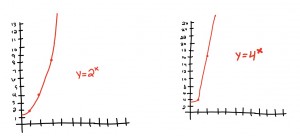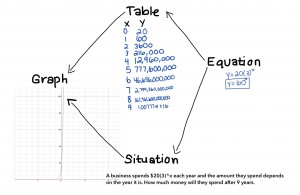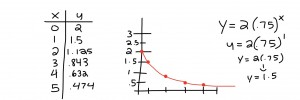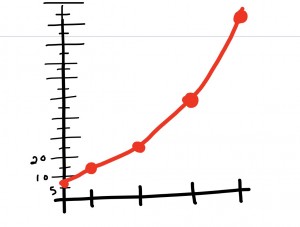Blog 29: Investigating Y=B^X:
In this lesson we learned about equations of exponential function which follow the form of y=b^x. As I completed the lesson I asked myself: What is it growing by? Is this a function? How can I write this as an equation? Is it increasing or decreasing. Each of these would help me come up with my equation. Changing the value of B in an equation will change the growth rate for example y=12^x isn’t as steep as y=16^x but is steeper than y=4^x. In this lesson I understood a little more about what exponential functions were exactly and what they meant. They represent any growth or change that doubles, triples, quadruples, decreases by 1/2 or 1/4, etc. Now, I have developed more types of relationships between the x and y values.
Blog 30: Multiple Representations Web for Exponential Functions:
In an exponential function you can show many representations for functions such as equations, tables, graphs, and situations. In this chapter I learned how to use all of these representations. For example for the graphs we would be asked to find the equations that matches it. We have also used tables where we had to fill in the missing values based on the ones we were given
Blog 31: Updated Web for Exponential Functions:
This lesson was about compound interest and simple interest. We were given a situation about bank interest and had to find the amount after a number of years/months. To solve the problems in the lesson I had to use tables, graphs and equations to help graph. These are the same representations that I used in previous lessons. I think I am very well at using all of these representations when it comes to these types of problems. I can use the tables to see the difference between two numbers and find what the growth/decrease is. I can also use the graphs to help fill in the missing points and see exactly how the value is increasing. The equation can be used to find out what the answer will be as well. For example with these types of problems if you have the equation y=2(.75)^x all you do is fill in the x and then solve to find your answer.
Blog 32: Graph to Equation for Exponential Functions:
When you are given a graph and need to find the next values in n exponential relationship the best thing to do is write an equation. Usually the y-intercept is a given on the graph so in that case you fill in the formula of y=ab^x. The a means y-intercept and b is the growth. X is the amount of time that has passed. So let’s use a graph with a y-intercept of 6 as an example. So far you have y=6(b)^x. Now let’s say the following points are part of the function: (0,6) (1,12) (2,24) (3,48) (4,96). So if you look at the y-values you can see they are doubling for each x value that passes. So now the equation is y=6(2)^x. When you are writing these equations you only have to find the ab values because the x and y are the coordinates.
Blog 33: Important Ideas About Exponential Functions:
Based on what I have learned about exponents I feel pretty confident in writing equations and other things. Some main things that I would present to someone about exponential functions are that exponential functions are used to describe a rate of growth that is different from linear. Exponential functions are when a value increases or decreases by a precise value but then you bring it to the power of x. They differ from linear equations because of how they do not increase at the same rate of change or make a straight line on a graph. Exponential equations/functions can be used to represent interest or money someone makes or loses. They come in the form of y=ab^x where a means the y-intercept and b is the growth.









Leave a Reply